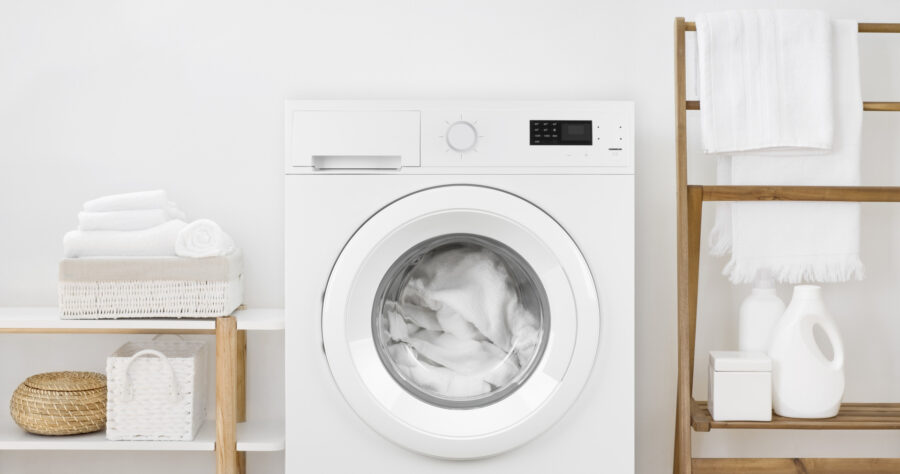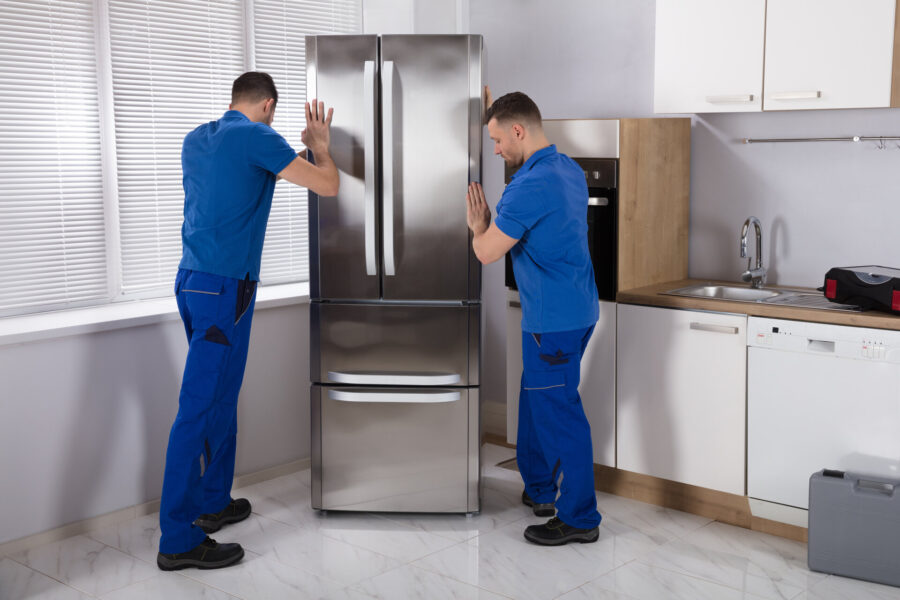Relocating can be an adventure, especially if you’re employing the services of long-distance movers. However, one of the most challenging tasks is learning how to move a washing machine and other appliances. A feat like this requires a delicate balance of brute force and finesse, which you can learn about here.

Why You Need to Learn How to Move a Washer Safely
Whether you’re engaging the services of a long-distance moving company or organizing movers from Seattle to California, there are certain items movers won’t move, and a washing machine can be one of them.
This is because they’re bulky, heavy, and require special care to prevent damage. Therefore, knowing how to transport your washer safely can be a game-changer. It’s one of the most practical relocation tips you need to master.
Preparing for the Big Move: How to Drain a Washing Machine for Moving
Draining your washing machine is one of the fundamental steps every cross-country moving company would advise you to take. It’s all about relocating efficiently and avoiding common relocation mistakes. This mistake can be made even when you hire long-distance moving services since you must drain the washer yourself.
After your last load of laundry, let the machine run an extra cycle to drain all the water. If any of it remains, it can lead to leaks or damage to the appliance or other items during relocation.

Analyzing the Load: Moving a Front Load Washer vs. A Top Load Washer
When planning to relocate your laundry appliances, understanding the type of washer you have is a non-negotiable first step. Whether you own a front load or a top load washer, each has its unique characteristics, affecting how you prepare the machine for the move, your relocation inventory, and how you load and pack the relocation truck.
Key Differences in Moving a Front Load and Top Load Washer
Front and top load washers are designed differently, with variations in size, weight, and shape. These differences come into play when shifting them, especially when relocating into an apartment with potentially tight spaces or executing a last-minute move.
Top-load washers are usually lighter, more balanced, and easier to transport. This ease of movement is because their design is essentially symmetrical, with the weight evenly distributed. This symmetry can make it easier to handle while relocating.
On the other hand, front-load washers are typically larger and heavier, primarily due to the position and weight of the drum. The drum is located at the front, meaning the machine’s weight is not evenly distributed and is more challenging to maneuver.
These differences in weight and design mean that the approach to transporting each type will be somewhat different. Consider your washer’s dimensions and weight when preparing for relocation, selecting the right tools and materials, and planning how best to maneuver the machine through doorways and corridors.
Special Precautions for Moving a Front Load Washer
Due to their design and weight, front-load washers require extra caution and preparation when being moved. The drum, particularly, can be prone to damage if not properly secured.
Before relocating a front load washer, secure the drum using transit bolts, which prevent it from shifting and potentially getting damaged while in transit. These bolts are typically supplied with the machine when first purchased, but if you’ve misplaced them, they can usually be obtained from the manufacturer or a local appliance store.
Additionally, due to the added weight and uneven weight distribution of front load washers, you may need to purchase or rent special relocation equipment to handle the machine safely. A heavy-duty appliance dolly with straps is an essential tool for this job if you want the washer to remain one of the things you need for your first apartment.
Furthermore, when loading a front load washer onto the relocation truck, it’s advisable to keep it upright. Laying it on its side can cause the drum to shift, potentially causing damage.
The Solo Mission: How to Move a Washing Machine by Yourself
Embarking on a solo mission to transport your washer can be an empowering experience, particularly if you’re relocating to another state alone. However, the task is not without its challenges, and it’s crucial to be well-prepared and mindful of safety precautions with moving into a new house checklist.
Here are some essential tips for lifting your appliance single-handedly.
Safety Considerations for Moving a Washer Alone
One of the most critical aspects of shifting a washer by yourself is ensuring your safety. Its weight and bulk can cause injury if you don’t handle it correctly. Here are some safety tips to follow:
- Proper lifting techniques – Always bend at the knees, not the waist, when lifting heavy objects. Keep your back straight, grasp the item firmly, and use your legs to lift. This technique minimizes the strain on your back,
- Wear appropriate clothing and footwear – Wear comfortable, non-restrictive clothing and closed-toe shoes with good grip to prevent slipping,
- Clear your path – Ensure that the path you’ll use to maneuver the washer is free of obstacles and debris that could cause you to trip or lose your balance,
- Take your time – Don’t rush the process. Shifting a washer alone is physically demanding, so give yourself ample time to complete it without compromising your safety.
Tips for Single-Person Moving Techniques
Even if you’re relocating alone, you can leverage various tools and techniques to reduce physical strain. Here are some helpful tips:
- Use furniture sliders – Place furniture sliders under each corner of the appliance to slide it across the floor with ease,
- Employ lifting straps – Lifting straps or shoulder dollies help lift the appliance without putting excessive pressure on the back. These straps distribute the weight evenly across your body,
- Utilize an appliance dolly – An appliance dolly is a must-have tool for single-person moves. It can handle the weight of a washer and make it easier to transport the appliance, particularly when navigating stairs or uneven surfaces,
- Secure the washing machine – When shifting the washer, ensure it is secured to the dolly or other equipment. This will prevent it from shifting or falling,
- Seek assistance if needed – If you find moving the washer by yourself too difficult or risky, ask for help from friends or family or hire professional movers.
The key is to prioritize safety, use the right tools and techniques, and be patient. If you don’t know how to use some of the tools listed in the tips, watch the video below; the man in it explains the essentials and how they’re used.
Rolling With Ease: How to Move a Washing Machine With a Dolly
When embarking on a significant relocation adventure, such as relocating out of state or to a new city, an appliance dolly can be a lifesaver. This handy tool is designed to transport heavy items just like your washing machine, turning a potentially strenuous task into a manageable one.
Types of Dollies Suitable for Moving a Washer
There are various types of dollies available, but for shifting a washing machine, an appliance dolly is your best bet. Appliance dollies are specifically designed to handle heavy loads like washing machines, refrigerators, and other large appliances.
They are typically made of durable, heavy-duty steel and feature large rubber wheels that can navigate various terrains, including stairs and uneven surfaces. They also usually come with built-in straps or a securing mechanism to keep the appliance firmly in place during transport.
Step-By-Step Guide for Using a Dolly
Using an appliance dolly to relocate and transport a washer is a straightforward process. Here’s a step-by-step guide:
- Position the dolly – tilt the washing machine slightly and slide the dolly underneath it. Make sure the machine is centered on the dolly platform for optimal balance.
- Secure the washer – Use the dolly’s straps to secure the washer. The straps should go around the middle of the machine and be tightened securely. This will prevent the washer from shifting or falling,
- Keep the dolly upright – With the appliance secured, tilt the dolly back until it’s balanced on its wheels. Always keep the dolly upright to maintain balance and control,
- Transport the washer – Use the dolly’s wheels to transport the washer to the truck. Push the dolly forward to move, and pull back on the handles to slow down or stop. Take your time and go at a comfortable pace, especially when navigating stairs or uneven surfaces,
- Load onto the truck – Once you reach the truck, use the dolly’s stair climber feature (if available) to get the appliance into the truck. Keep the machine strapped to the dolly until it’s securely in place,
- Unload the washer – After reaching your destination, reverse the process to unload the washer from the truck and into its new location.
Packing It Up: How to Pack a Washing Machine for Moving
Transporting a washer is not as simple as unplugging it and loading it onto a truck. To ensure it arrives at the destination in the same condition as it left, you must take the time to properly pack and prepare it for the journey.
Firstly, gather some essential packing materials. Bubble wrap and blankets are two key items that you’ll need to protect your washing machine from scratches and dents during shipping.
These items can be wrapped around the machine to provide a cushioning layer and help prevent damage caused by the appliance being bumped or jostled during transport.
Once you have your materials, thoroughly wrap the appliance in bubble wrap. Cover all its surfaces, paying particular attention to protruding parts such as knobs or dials that could potentially be damaged in transit.
Next, cover the machine with a blanket. Secure it in place with tape, ensuring that it’s tight enough to hold but not so tight that it puts pressure on any delicate parts of the machine.
Other Materials Needed for Packing a Washing Machine
Besides bubble wrap and blankets, you’ll also need tape to secure the protective materials around the washing machine, ensuring they stay in place throughout the move.
Finally, if the size of your washing machine allows, consider investing in a sturdy box. This can serve as an additional layer of protection for your appliance, adding stability and helping to shield it from potential impact.
If you’re using a relocation box, place the wrapped washer into it. Fill any empty space in the box with additional bubble wrap or paper to prevent the machine from shifting inside the box during shipping. Close the box and seal it with tape.

Getting Ready for the Journey: How to Prepare a Washing Machine for Moving
Preparing your washer for relocation involves a series of steps designed to protect it and ensure it reaches its destination in working condition. Including this on your relocation list of tasks will make your time to move easier and protect the washer.
Here are the essential steps for properly preparing and relocating your washing machine.
Detach Hoses and Cords
First, you need to disconnect all cords and hoses. Drain the hoses before packing them separately. Electrical cords should be taped securely to the machine to prevent them from getting damaged or causing accidents during transport.
Secure the Drum and Other Internal Components
The drum and other internal components of your washer need to be secured. You can use transit bolts provided by the manufacturer to do this. If you no longer have these, consult your manufacturer or a local appliance store for alternatives.
Perform Final Checks Before Relocating
Before relocating, perform a final check. Ensure the washer’s door is closed and secure and all loose parts are accounted for and packed separately. Take this time to go through your new apartment checklist and ensure you’ve settled all necessary tasks before relocating.
If you hire a relocation company to help you manage this process better, remember to research how to tip movers. They’ll ensure your washer is loaded and delivered without mistakes, so trusting them would be wise.
Packing Services
Our professional packers have methods and techniques to ensure all your items are intact during and after the move.
Storage Services
Looking for storage space while you get settled? California-Seattle Express provides 30 days free storage with your move.
Car Shipping Services
We can ship your vehicles using the best freight options available. Your car will be moved safely and securely and arrive as planned.
If Moving a Washing Machine Yourself Gets Tough, Contact Cross-Country Movers of California Seattle Express
There’s no doubt that relocating a washer is challenging. But remember, if you start to feel overwhelmed, there’s no shame in calling in the experts. The California-Seattle Express specializes in cross-country moves, and we’re equipped to handle all your relocation needs, including transporting bulky appliances.
Whether you relocate your washing machine yourself or hire movers, it’s essential to plan, have the right tools, and ensure the safe transit of your appliance. Remember who to notify when relocating, and if you opt for hiring movers, consider our movers from Seattle to California for seamless, stress-free relocation and stellar packing services.
FAQ
What Are the Important Considerations When Moving a Washer?
Key considerations include the type of washing machine, its size and weight, the proper disconnection of hoses and cords, the securement of internal components, and suitable packing materials to protect the machine during shipping.
How Should I Prepare My Washing Machine Before the Move?
Firstly, run a final cycle to clean and drain the machine. Disconnect all hoses and electrical cords, draining the hoses completely. Secure the drum and other internal components using transit bolts, then wrap the washer with protective materials.
Are There Any Special Tools or Equipment Required for Moving a Washer?
Yes. You’ll need an appliance dolly to transport the machine, lifting straps to secure it to the dolly, and packing materials such as bubble wrap, relocation blankets, and packing tape for protection.
Can I Move a Washing Machine by Myself, or Do I Need Help?
Transporting and lifting a washing machine by yourself is possible, but due to its weight and bulkiness, you should have at least one other person to help or hire professionals.
How Do I Safely Disconnect the Water and Power Supply for the Washing Machine?
First, unplug the washing machine from the electrical outlet. Then, turn off the water supply valves. Disconnect the hoses from the water supply, ensuring to drain any remaining water.
What Precautions Should I Take To Prevent Damage to the Washing Machine During the Move?
Wrap the machine in relocation blankets and bubble wrap to prevent scratches and dents. Secure the drum and other internal components to prevent them from moving around. Pack the machine properly onto the relocation truck, ensuring it’s well-secured and won’t shift during transit.
Are There Any Specific Instructions for Loading the Washing Machine Onto a Truck?
Use an appliance dolly to shift the machine. Ensure it’s balanced and secure on the dolly before shifting it. Load it onto the truck carefully, placing it where it’s less likely to shift during shipping.
How Do I Secure the Washer to Prevent It From Shifting During Shipping?
Once the washer is in the relocation truck, use the lifting straps to secure it to the side of the truck. Ensure it’s not likely to roll or shift during transit.
What Steps Should I Follow to Reinstall the Washing Machine in Its New Location?
Once at your new location, use the dolly to move the washer to its new spot. Reconnect the hoses to the water supply and the cord to the power supply. Remember to remove the transit bolts before running the machine.
Are There Additional Tips or Advice for a Smooth and Successful Washing Machine Move?
Plan, start early, and don’t rush the process. Make sure you have all the necessary tools and materials before starting. If you’re unsure at any point, call professionals. Finally, always prioritize safety over speed.




